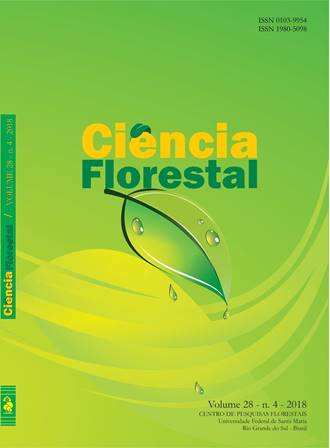OCCURRENCE OF ROOT BUDS IN <i>Tabebuia roseoalba</i> (Ridl.) Sandwith (BIGNONIACEAE, LAMIALES)
DOI:
https://doi.org/10.5902/1980509835338Keywords:
ipê-branco, vegetative propagation, reparative buds.Abstract
The species Tabebuia roseoalba, present in the native flora of cerrado, exhibits vegetative propagation in the natural environment. The presence of underground systems that produce buds in woody tree species is related to survival under environmental disturbances. Thus, the aim of this work was to analyze and characterize anatomically the underground system producing shoot-buds in the Tabebuia roseoalba species. The material used in the investigation (plagiotropic roots) were cut into ten centimeters long segments, rinsed with water and planted in plastic pots with vermiculite. The segments were kept in a thermostatic chamber during 60 days. After, the material was hand sectioned and then stained with safranin and methylene blue for the microscopic examination. The results indicate that the underground system analyzed has a characteristic arrangement of roots with the protoxylem poles on the outer side (exarch) and the center of the structure is made up entirely of xylem. The characteristics observed in this work lead to propose that the buds are reparative in which their formation is linked to any environmental disturbance in the underground systemDownloads
References
APPEZZATO-DA-GLÓRIA, B. Morfologia de sistemas subterrâneos: histórico e evolução do conhecimento no Brasil. Ribeirão Preto: A. S. Pinto, 2003. 80 p.
APPEZZATO-DA-GLÓRIA, B.; HAYASHI, A. H. Raiz. In: APPEZZATO-DA-GLÓRIA, B.; CARMELLO-GUERREIRO, S. M. (Org.). Anatomia vegetal. 2. ed. Viçosa, MG: Ed. UFV, 2006. p. 2267-2282.
BARROSO, G. M. Sistemática de angiospermas do Brasil. Viçosa, MG: Ed. UFV, 1991. v. 3. 326 p.
BECK, C. B. An introduction to plant structure and development: plant anatomy for the twenty-first century. 2nd ed. Cambridge: Cambridge University Press, 2010. 441 p.
CAMARGOS, V. L. et al. Avaliação do impacto do fogo no estrato de regeneração em um trecho de Floresta Estacional Semidecidual em Viçosa, MG. Revista Árvore, Viçosa, MG, v. 34, n. 6, p. 1055-1063, 2010.
CHAVES FILHO, J. T.; BORGES, J. D. Propagação vegetativa da espécie arbórea Handroanthus serratifolius (Vahl) S. O. Grose através de raízes gemíferas. In: CONGRESSO FLORESTAL NO CERRADO, 1.; SIMPÓSIO DE EUCALIPTOCULTURA EM GOIÁS, 3., 2013, Goiânia. Anais eletrônicos... Goiânia: Universidade Federal de Goiás, 2013. Disponível em: <http://www.congressoflorestal.com.br/2013/anais/files/0117.pdf>. Acesso em: 04 abr. 2015.
CUTLER, D. F.; BOTHA, T.; STEVENSON, D. W. M. Anatomia vegetal: uma abordagem aplicada. Porto Alegre: Artmed, 2011. 304 p.
EVERT, R. F. Anatomia das plantas de Esaú: meristemas, células e tecidos do corpo da planta, sua estrutura, função e desenvolvimento. São Paulo: Blucher, 2013. 726 p.
FELFILI, J. M. Principais fisionomias do espigão mestre do São Francisco. In: FELFILI, J. M.; SILVA JÚNIOR, M. C. (Org.). Biogeografia do bioma cerrado: estudo fisionômico na chapada do espigão mestre do São Francisco. Brasília: Universidade de Brasília, 2001. p. 18-30.
GONÇALVES, E. G.; LORENZI, H. Morfologia vegetal: organografia e dicionário ilustrado de morfologia das plantas vasculares. São Paulo: Instituto Plantarum de Estudos da Flora, 2007. 416 p.
GOTTSBERGER, G.; SILBERBAUER-GOTTSBERGER, I. Life in the Cerrado: a South America tropical seasonal ecosystem. Ulm: Reta Verlag, 2006. v. 1. 277 p.
HAYASHI, A. H. Morfo-anatomia de sistemas subterrâneos de espécies herbáceo-subarbustivas e arbóreas, enfatizando a origem de gemas caulinares. 2003. 143 f. Tese (Doutorado em Biologia Vegetal) – Universidade Estadual de Campinas, Campinas, 2003.
HOFFMANN, W. A. Fire and population dynamics of woody plants in a neotropical savanna: matrix model projections. Ecology, Brooklyn, v. 80, n. 4, p. 1354-1369, jun. 1999.
JUDD, W. S. et al. Sistemática vegetal: um enfoque filogenético. 3. ed. Porto Alegre: Artmed, 2009. 632 p.
KLINK, C. A.; MACHADO, R. B. A conservação do cerrado brasileiro. Megadiversidade, Belo Horizonte, v. 1, n. 1, p. 147-155, jul. 2005.
KRAUS, J. E.; ARDUIN, M. Manual básico de métodos em morfologia vegetal. Seropédica: EDUR, 1997. 198 p.
LARCHER, W. Ecofisiologia vegetal. São Paulo: RiMA, 2000. 531 p.
LORENZI, H. Árvores brasileiras: manual de identificação e cultivo de plantas arbóreas nativas do Brasil. 7. ed. Nova Odessa: Instituto Plantarum de Estudos da Flora, 2016. v. 1. 384 p.
MACHADO, S. R.; CARMELLO-GUERREIRO, S. M. Floema. In: APPEZZATO-DA-GLÓRIA, B.; CARMELLO-GUERREIRO, S. M. (Org.). Anatomia vegetal. 2. ed. Viçosa, MG: Ed. UFV, 2006. p. 155-178.
MENDONÇA, R. C. et al. Flora vascular do Cerrado. In: SANO, S. M.; ALMEIDA, S. P. Cerrado: ambiente e flora. Planaltina: EMBRAPA CPAC, 1998. p. 289-556.
PAULA, J. E.; ALVES, J. L. H. Madeiras nativas: anatomia, dendrologia, dendrometria, produção e uso. Brasília: Fundação Moikiti Okada, 2007. 544 p.
RATTER, J. A.; RIBEIRO, J. F.; BRIDGEWATER, S. The brazilian cerrado vegetation and threats to its biodiversity. Annals of Botany, London, v. 80, n. 3, p. 223-230, mar. 1997.
REATTO, A. et al. Solos do bioma Cerrado: aspectos pedológicos. In: SANO, S. M. et al. (Org.). Cerrado: ecologia e flora. Brasília: Embrapa, 2008. p. 109-149.
RIBEIRO, J. F.; WALTER, B. M. T. As principais fitofisionomias do bioma Cerrado. In: SANO, S. M. et al. (Org.). Cerrado: ecologia e flora. Brasília: Embrapa, 2008. p. 151-212.
SILVA, F. A. M.; ASSAD, E. D.; EVANGELISTA, B. A. Caracterização climática do bioma Cerrado. In: SANO, S. M. et al. Cerrado: ecologia e flora. Brasília: Embrapa, 2008. p. 71-88.
SOUZA, V. C.; LORENZI, H. Botânica sistemática: guia ilustrado para identificação das famílias de fanerógamas nativas e exóticas no Brasil, baseado em APGIII. 3. ed. Nova Odessa: Instituto Plantarum de Estudos da Flora, 2012. 768 p.
YANES, C. V. et al. La reproducción de las plantas: semillas y meristemos. México: FCE, 1997. 168 p.







